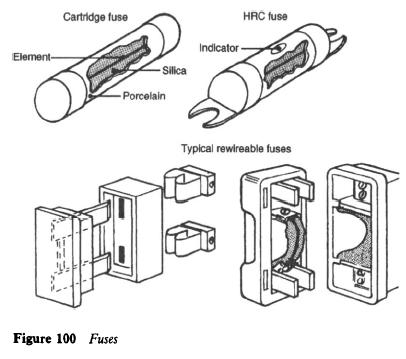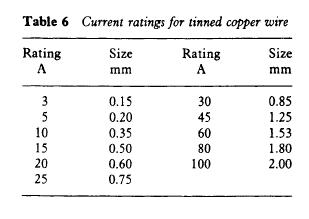Refrigerator Troubleshooting. Fuses
Three types of fuses (Fig. 100); rewireable or semi-enclosed fuse, fuse holder, or a fuse; and high breaking capacity (HRC) fuse. Rewireable fuse This includes mount fuse element and fuse holder. The owner and the carrier can be made of porcelain or bakelite. Fuse holder color coded as follows: 45 AB green
30 AB red
20 AB yellow
15 AB In blue
5 AB In white This type of fuse popular home appliances and small commercial units, because of cheapness and ease of replacement. Not recommended for commercial refrigeration debt because of these drawbacks: 1. Fuse carrier can be downloaded from the wrong size fuse wire.
2. Fuse element leads to a weakening after long-term use due to oxidation of wire when heated in air. This leads to fail under normal conditions, i.e.. the usual initial surges located on the fuse overload. 
3.
Fuse carrier and the carrier may be damaged as a result of arcing in case of overload. Fuse holder It consists of porcelain tube with metal caps, which fuse element is attached. The tube is filled with silica. These fuses can be used in the connector from the top of a 13A socket and switchboards. They are recommended for cooling duty. They have advantages over rewireable types are not getting worse, to be more exact, in the breaking of the nominal value, not being subject to the arc. - Fuses This is an advanced version of the fuse holder. It is normally used to protect the motor circuit in commercial and industrial installations. It consists of porcelain body filled with silica and with a silver member body terminates the lug-type end caps.
These fuses are acting quickly, and can be distinguished from over voltage and over. An indicating element shows when the fuse is broken. Rating Selection of fuses depends on the full load current, locked rotor and cable size. The current ratings of the tinned copper wire, are presented in Table 6. Fusing factor Different types of fuses provide different levels of protection. Rewireable fuses slower and are less accurate than cartridge types. Classify protection devices, it is important to know rafting performance. This is achieved by fusing factor: 
Here fuse current minimum current causing the fuse to tear, and a current of maximum current which fuse can withstand without rupture. For example: 1. 5 fuse breaks only when 9 threads; he has a fuse factor 9/5 or 1.8. 
2. The current rating of the fuse holder 30 and fusing factor of 1.75; fuse will break in 30 1,75 = 52.5 A.
3. current rating of the fuse, 20-a, fusing factor 1,25; fuse will rupture 20 x 1.25 = 25. Therefore, it should be understood that the fuse is designed for the amount of current, it can carry, and not the amount at which it will break. Rewireable have fuses, fuse factors approximately 1.8; fuse holder of 1.25 and 1.75; - fuses to 1.25 maximum; and motor cartridge fuses of 1.75. ..
|
